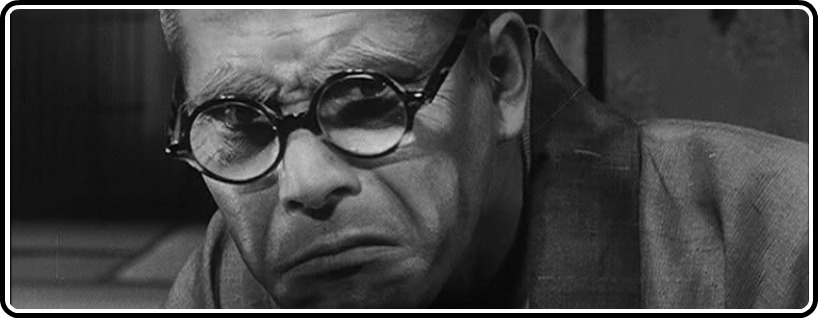
I keep thinking about the H-bomb, but all I can do is think! …
It’s a living hell!
This week’s selection for the Journey Through the Eclipse Series is driven by a desire to maintain some continuity with my Criterion Reflections blog. On that site, I’ve been watching and writing about films released by the Criterion Collection in their original order of release (as films, not DVDs.) I Live in Fear, a 1955 film featured in Eclipse Series 4: Postwar Kurosawa, just happens to fall in line with my most recent review over there, Alain Resnais’ Night and Fog. So during the past few days, just like a small handful of movie watchers in late 1955, I’ve been contemplating those two great horrors of the World War II era: first, the Holocaust, and now the prospect of death by nuclear attack and radioactive fallout. Anyone got a Xanax they can spare? I’m feelin’ kinda shaky at the moment!
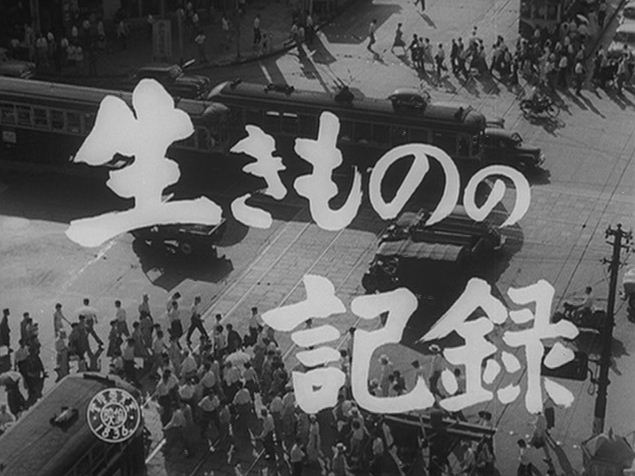
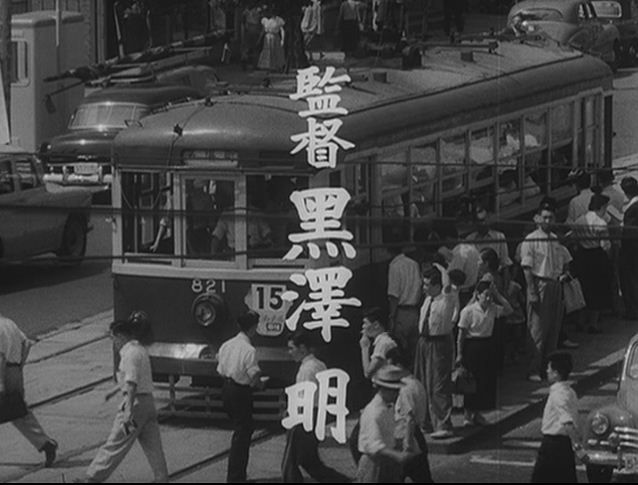
I Live in Fear opens with shots of busy Tokyo intersections, accompanied by music of the theremin, that eerie high pitched electronic wail that instantly signals 1950s Atomic Age paranoia. I’m used to hearing it in American sci-fi of the period and was impressed/surprised to hear it used in this Japanese setting. Music is a universal language indeed! The action opens with a dentist taking a phone call right in the middle of doing a check-up – I could hardly imagine such a thing happening nowadays. He’s summoned to a family court hearing, where he serves as a mediator for the purpose of resolving domestic disputes. He’s apparently forgotten about his commitment and now has to wrap up business lickety-split to make it to the hearing on time. As a result, some lucky kid gets out of his dentist appointment…
Upon arrival, Dr. Harada is plunged into a roiling dispute afflicting the family of Kiichi Nakajima, a wealthy, aging industrialist whose increasingly eccentric behavior is creating a rift between him and his dependents. Further complicating matters, we quickly learn that his offspring include more than just the children that he and his wife have raised. He’s also the father to three other children, through three different mistresses he’s had over the course of his career. Though polite conversation and customs prevented these people from openly acknowledging each other’s existence for some years, new realities compel them to dispense with such formalities. Tensions are already at a boiling point as we get to know the basic facts of the case. Mr. Nakajima, used to calling the shots after years of ruling his steel foundry with an iron fist, is facing unexpected opposition by his own sons, Ichiro and Jiro, who serve as spokesmen for the rest of the family. They oppose the old man’s desire to sell off the family assets and relocate the whole bunch of them to, of all places, Brazil. Kiichi’s outrage at this resistance from sons he no longer respects pushes him over the edge. In the first of several physical outbursts, he slams the desk of the mediators, knocking over a water glass and driving his poor wife to tears.
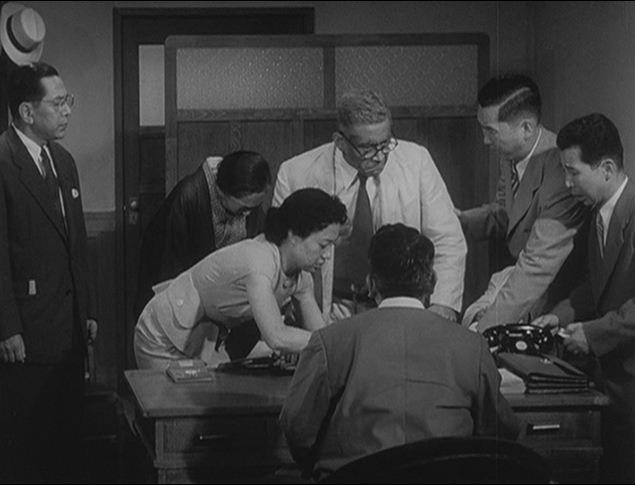
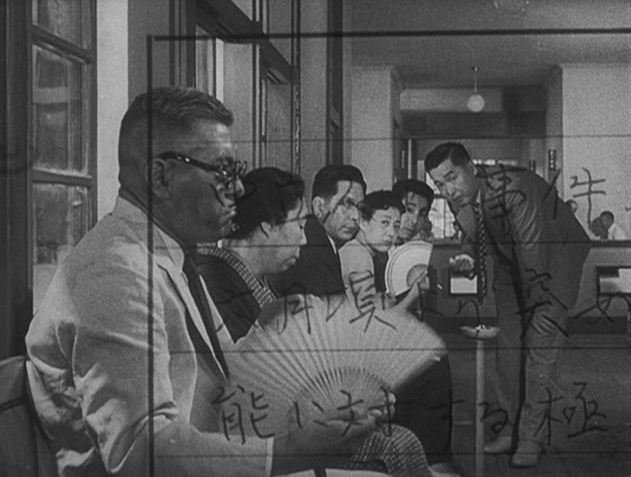
Unfazed by Mr. Nakajima’s blowup, Mr. Hori from the bar association patiently explains the purpose of the family court: to resolve conflicts between spouses, siblings and generations by patiently listening to all points of view, considering the merit of each, and doing their best to guide the disputants toward the most amicable solution. Clearly, in 1955, Japanese society is at a different place than it was in the past, as recently as the war years, when solemn paternal decrees were issued and obeyed without question. I Live in Fear is, among other things, an attempt to grapple with new ways of coping with families in turmoil, reflecting the cognitive dissonance experienced by many, now that they are given a legal leg to stand on in denying their patriarch the obedient deference that in earlier times was naturally regarded as his due.
Akira Kurosawa employs an interesting device in illustrating how third-party rulings based on abstract principles of the law now govern modern Japanese life. As a petition is read, outlining the basis of the complaint against Mr. Nakajima, a dual exposure of the text is laid over images of the family as they sit on time-out in the hallway adjacent to the meeting room. Words on paper now limit a man’s ability to act, giving weight and substance to the rebellion and laziness of an ungrateful generation! Nakajima, who’s apparently built his steel foundry business from scratch, must now suffer the indignity of seeing his role as head of the clan subverted by sons who fail to grapple with the threat from which he seeks to protect them.
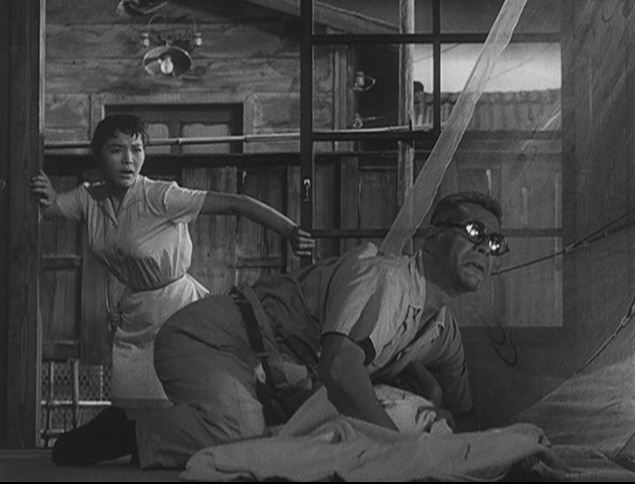
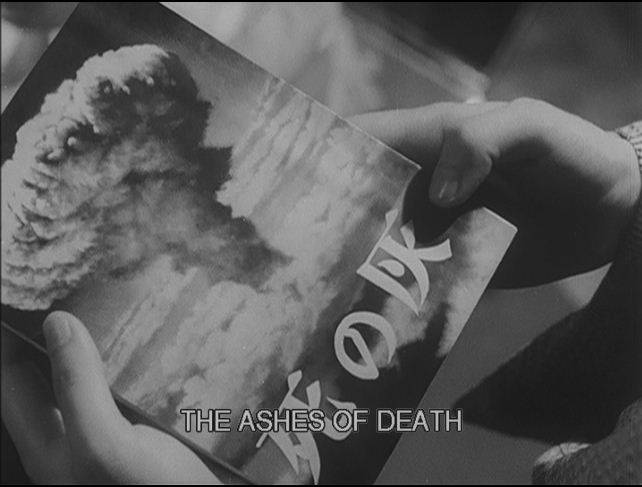
And what is the nature of this threat? Nothing less than instant, horrific death through an atomic bomb attack, or worse yet, exposure to the terrible radiation that is certain to sweep over Japan whenever the Big One drops. Mr. Nakajima, you see, is the one who says I Live in Fear – not always in so many words, but by his actions, flinching and cowering in a nervous heap when he hears jets flying overhead or sees a flash of lightning come through the window, convinced that the annihilation of all he holds dear is mere moments away. Those deeds also include more sustained efforts, like building an underground fallout shelter but then abandoning that task (at the cost of several million yen) when he learns new facts about the expected distribution of fallout patterns that would make the bunker ineffective. His new plans now revolve around emigration to Brazil, where we wants to swap his land with an expatriate farmer eager to return to his childhood home. He pursues this quest against everyone else’s wishes, since they’re content to take their chances in Japan with the other millions of their neighbors. The only route open to his sons, their wives and children, is to have Mr. Nakajima declared mentally incompetent, thus preventing him from selling the foundry and family properties out from under them.
This synopsis sets up the central tension of I Live in Fear, a story of inter-generational rivalries, shifting social mores and, most emphatically, Atomic Age paranoia run rampant in the fevered imagination of its flawed, painfully frustrating protagonist. Probably the most immediately amazing detail of this movie is that the lead character, Mr. Nakajima, is played by Toshiro Mifune, the brilliant actor best known to audiences then and now for his memorable performances in Kurosawa’s massively successful run of samurai features that began with Rashomon in 1950 and reached a new pinnacle with Seven Samurai (1954.) Mifune daringly transformed himself into the guise of a crumbling elderly man on the brink of losing his sanity while at the very peak of his physical powers, filming I Live in Fear between his outings in Seven Samurai and the MacBeth-inspired Throne of Blood, as well as his epic portrayal of samurai legend Musashi Miyamoto in the Samurai Trilogy directed by Hiroshi Inagaki. To fully appreciate Mifune’s courage in taking on this role, imagine some of the prototypical action stars of American cinema over the past couple of decades basically stripping themselves of their stock-in-trade just for the sake of stretching themselves professionally by playing a cranky old man. Even when Brad Pitt went through that old age transformation in The Curious Case of Benjamin Button, the marketing department made sure he had the opportunity to turn back into the “young and gorgeous” version of himself that was featured on the posters!
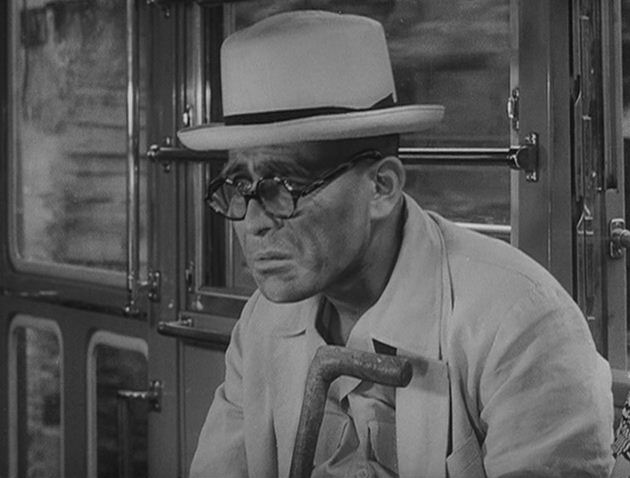
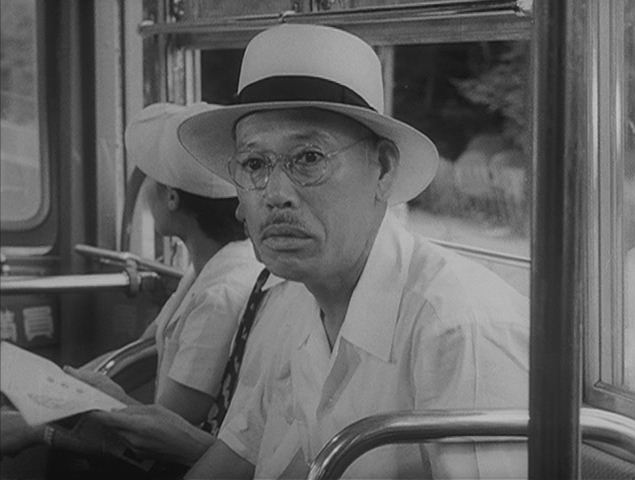
Mifune’s experiment isn’t necessarily the most rousing success – he labors a bit to contain his wild, animalistic energy and the makeup only goes so far in disguising his handsome features – but I admire the effort, keeping us mindful of the enormous power that Mr. Nakajima wielded in his prime as he juggled business matters and his personal affairs without paying much heed to future complications. Likewise, the subdued meekness of the dentist Harada serves as a study in contrast for Takashi Shimura, the venerable warrior-sage Kambei of Seven Samurai who dials down the majestic awesomeness of that role to take on one drenched in ambivalence and befuddledness. Harada’s character serves as the prime point of access for most viewers – he’s the first character we meet and he’s the one who strives the hardest to stay objective in regard to the underlying dilemma of I Live in Fear: Is it rational or irrational to allow our dread of nuclear weapons to establish the guidelines by which we live?
Before we provide too glib of an answer to that question, consider the circumstances of Japan in 1955. Scarcely ten years had past since the nation had suffered two atomic attacks. The Soviet Union and the United States were deadlocked in the Cold War, China and Korea, neighbors to the East, were both hot zones of geopolitical conflict, and Japan possessed no serious deterrent force of its own. As eccentric and extreme as Nakajima’s fears may seem to us now, he only stood out because his resolution to do something that would allow him and his family to escape the danger was backed up by the financial means to do so. But that resolve meant unwanted disruption and relocation to younger generations who had somehow come to terms with living in such peril, and they wanted no part of it. In a sense, Kurosawa was posing a question that ran through his earlier postwar films: given our past and the conditions of the here and now, what kind of society will we become in the future? I think his response in I Live in Fear denies the option of simple escapism but also cautions against materialistic complacency. Though we might be tempted to side with Nakajima’s children in the underlying dispute, there’s not much to be applauded in the petty squabbling that takes place among their ranks. Tempers flare on several occasions to the point where family members come to blows and its definitely not played for laughs. These are people in crisis, with no easy solutions to be found.
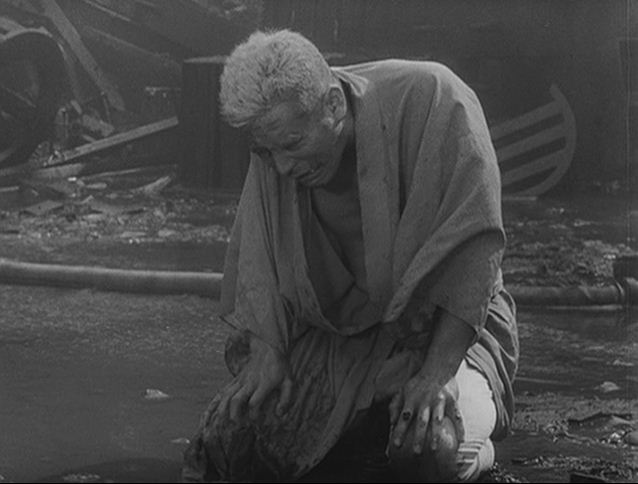
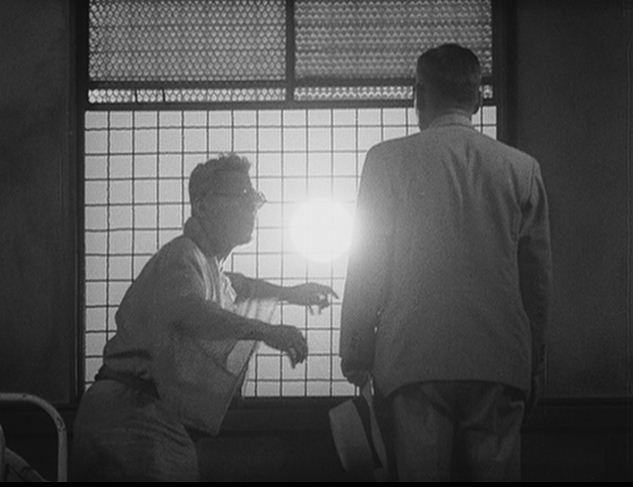
As the film concludes, I Live in Fear jumps to a level of high pathos that may not play well with some viewers. Nakajima takes drastic measures to sway his children to see things his way and everyone winds up paying a dreadful price for his folly. The Kurosawa theme of an utterly bereft and shattered old man floundering in the mud makes an appearance here, setting the stage for future expansions of this scenario in Ran, among others. My hunch is that this kind of nervous breakdown plays better in “classical” settings, at least for Western viewers who are used to Shakespearean characters groveling in tragic misery. The drastic fall of a contemporary corporate titan like Nakajima, for various reasons doesn’t seem as likely, and that may be one reason that I Live in Fear turned out to be one of Kurosawa’s least commercially successful films. The relatively small cinematic canvas allowed fewer opportunities for Kurosawa to show off his ability to viscerally enhance the viewing experience through camera work and editing, though there are enough moments to reward fans of his art. It also brought to an end his alternating pattern of historical followed by contemporary films, at least for the remainder of the 1950s. After seeing the international critical and financial success of Rashomon and Seven Samurai, Kurosawa and Toho Studios recognized the obvious: AK could make a lot more money cranking out the samurai films than he ever could making films focused on the plight of modern Japan. With films like Throne of Blood, Yojimbo, Sanjuro and The Hidden Fortress in his future, who could ever complain about the direction his career took? Still, I Live in Fear powerfully captures the genuine anxiety and uncertainty that beset a nation at a critical juncture in its history. I’m glad that, for now, those worst fears have not yet been realized.





![Bergman Island (The Criterion Collection) [Blu-ray]](https://criterioncast.com/wp-content/uploads/2022/11/bergman-island-the-criterion-collection-blu-ray-400x496.jpg)
![This Is Not a Burial, It’s a Resurrection (The Criterion Collection) [Blu-ray]](https://criterioncast.com/wp-content/uploads/2022/11/this-is-not-a-burial-its-a-resurrection-the-criterion-collection-blu-ray-400x496.jpg)
![Lars von Trier's Europe Trilogy (The Criterion Collection) [The Element of Crime/Epidemic/Europa] [Blu-ray]](https://criterioncast.com/wp-content/uploads/2022/11/lars-von-triers-europe-trilogy-the-criterion-collection-the-element-of-400x496.jpg)
![Imitation of Life (The Criterion Collection) [Blu-ray]](https://criterioncast.com/wp-content/uploads/2022/11/imitation-of-life-the-criterion-collection-blu-ray-400x496.jpg)
![The Adventures of Baron Munchausen (The Criterion Collection) [4K UHD]](https://criterioncast.com/wp-content/uploads/2022/11/the-adventures-of-baron-munchausen-the-criterion-collection-4k-uhd-400x496.jpg)
![Cooley High [Criterion Collection] [Blu-ray] [1975]](https://criterioncast.com/wp-content/uploads/2022/11/cooley-high-criterion-collection-blu-ray-1975-400x496.jpg)
Wonderful Review, Dave. I am sure glad we don't live through such scary times…Atomic fears!
That's an interesting point you raise, Stan. Even in our post-9/11 era with the threat of terrorism (and the political exploitation of that anxiety) along with climate change and any number of other Big Dangers blared at us by the media in so many different ways, I don't think the sense of urgency quite matches what I remember from my youth when we used to have evacuation drills in our school's fallout shelter. There's something about that concept of instant obliteration raining down from the sky and frying us up in a moment that really haunts the imagination!